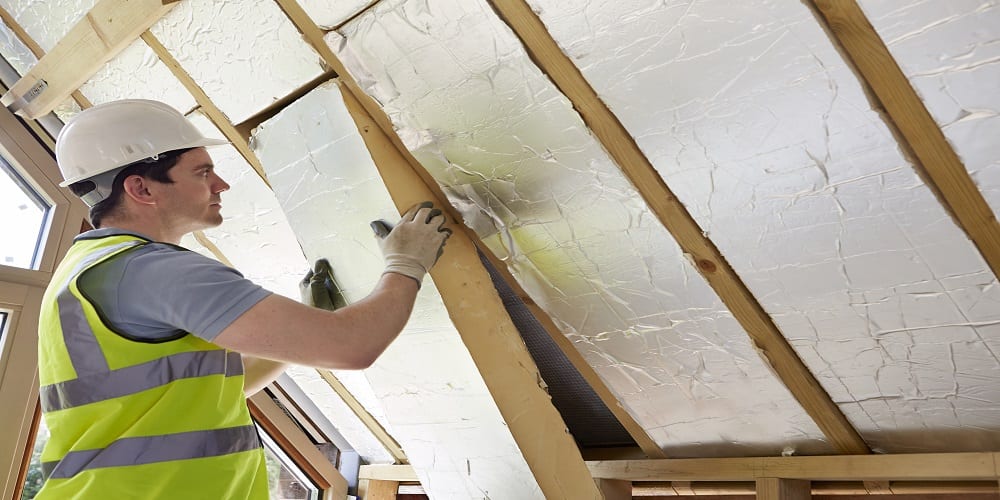Insulating your home will save you energy bills, keep you warm at home and contribute to a healthier environment. To make this investment even more interesting, both the government and municipalities offer various subsidy options. This article explains how much these subsidies amount to and how you can claim them.
How much does it cost to insulate a house?
Before looking at the subsidy options, let’s look at the cost of insulation. The prices of insulation differ depending on which part of your house is insulated and which insulation material you choose. In the price overview below you will find the average prices for glass wool insulation for a mid-terrace house in the Netherlands.
| Isolation measure | Surface area | Average cost of glass wool insulation |
|---|---|---|
| Speek wall insulation | 50 m2 | £ 750 – £ 2.000 |
| Floor insulation | 50 m2 | £ 850 – £ 2,200 |
| Roof insulation | 50 m2 | £ 1.200 – £ 2,750 |
| Facade insulation (interior or exterior facade insulation) | 50 m2 | £ 3,000 – £ 6,500 |
Find the best specialist for your project and get free quotes.
Start
Are you looking for detailed price information on insulation, for example of different types of material? Then take a look at the article: insulation prices.

What national subsidies are there?
What subsidies are there from the government and what conditions do you have to meet to claim them? The government provides subsidies for insulating owner-occupied homes and has schemes for this both for private individuals and for Owners’ Associations.
Everything about the ISDE scheme for private individuals
Before 2021, the national subsidy schemes for private individuals were regulated by the Subsidy Scheme for Energy Saving in the Home (SEEH). Since 2021, however, the SEEH has been replaced for private individuals by the Investment subsidy for sustainable energy and energy saving (ISDE).
What can you apply for a subsidy for?
The ISDE scheme allows you to apply for a subsidy for insulating your home, but also for a solar boiler, heat pump and the connection to a heat network: in other words, energy-saving measures. Insulating your home includes the following measures:
- Cavity wall insulation
- Interior and exterior wall insulation
- Roof insulation or attic floor
- Floor insulation or ground insulation
- HR++ or triple glazing, window panel or insulating door
Conditions for subsidy
To be entitled to the subsidy, you must make your home more energy efficient through one of the above measures. In addition, there are some conditions you have to meet to be entitled to the subsidy:
- You are the owner of the house and live there yourself.
- You have your house insulated by a company. So you may not do it yourself.
- The subsidy is applied for up to 24 months after carrying out the first measure.
- You meet the minimum number of m2 that must be insulated and the minimum insulation value set by the government as requirements.
The subsidy amount is doubled if you take a second insulation measure or combine the first insulation measure with a solar boiler, heat pump or connection to the heat network. These minimum requirements, as well as a comprehensive overview of all conditions and related details can be found on the website of the RVO.
Where do you apply for a subsidy?
Subsidy must be applied for within 24 months after the first measure has been implemented and paid for. Applying can be done on the website of the RVO. You will only receive a subsidy if you meet all the conditions set by the government.
The RFO’s step-by-step plan tells you exactly what these conditions are and which documents you need to complete the application successfully. Think for example of the invoice, proof of payment, but also the notification code. The notification code is important: without it, the application will take a very long time to process. The company that carried out the project for you knows the reporting code, although it is often already mentioned on the invoice. For each insulation measure, at least one photograph taken during the work must also be submitted. Check the step-by-step plan to make sure you do not forget anything.
May you combine subsidies?
You may combine the subsidy from the ISDE scheme with local subsidies from, for example, the municipality, the province or a water board if the ISDE subsidy was applied for after 21 April 2021. Read more about local subsidy options under the heading on municipal subsidies.
You may also combine the ISDE subsidy with a loan. There is a special Energy Savings Loan available for insulating your home. Read more about this loan later in this article.
The SEEH scheme for Owners’ Associations (VvE)
The SEEH does still apply to VvEs who want to save energy in their buildings and flats. The subsidy applies to VvEs, housing associations and housing cooperatives. Commercial properties are not entitled to subsidy through this scheme.
EvEs can apply for subsidy for various purposes: energy advice, process guidance, a multi-year maintenance plan and energy-saving measures, including insulation, in the buildings and flats. Detailed information on the SEEH scheme for VvEs and how to arrange an application can be found on the central government website.
Are there any local subsidies for insulation?
For subsidies around making your home more sustainable, you can also contact many municipalities, provinces or water boards. You can find an overview of the loan and subsidy possibilities for insulation in your region via the Energy subsidy guide.
How high is the subsidy on insulation?
The subsidy on insulation differs depending on which part of your house you have had insulated and how much m2 is insulated.
The subsidy is calculated as an amount per m2. There are both a minimum and maximum number of m2 that fall within the subsidy scheme. For projects implemented after 2 April 2022, the following applies. These amounts also apply for 2023.
| Measure | Subsidy per m2 (implemented after 2-4-2022) |
Min. m2 | Max. m2 |
|---|---|---|---|
| Cavity wall insulation | £4 | 10 m2 | 170 m2 |
| Roof insulation | £15 | 20 m2 | 200 m2 |
| Floor insulation | £5,50 | 20 m2 | 130 m2 |
| Attic floor | £4 | 20 m2 | 130 m2 |
| Gable insulation | £19 | 10 m2 | 170 m2 |
| Bottom insulation | £3 | 20 m2 | 130 m2 |
Lending money with the Energy Savings Loan
Are you a private homeowner? Then, in addition to subsidies, you can also pay for the insulation of your home with the help of a loan from the National Warmth Fund. For example, if you do not have sufficient savings yourself.
With this Energy Savings Loan you can borrow the money you need to insulate your home at a favourable rate. For example, for roof, floor or facade insulation. The term of this loan is between 7 and 20 years, depending on the amount you borrow. The interest rate of the loan is fixed throughout the term. With this loan, you can borrow a minimum of £2,500 to a maximum of £65,000, depending on your situation and wishes. Of course, borrowing money costs money.
Take advantage of the reduced VAT rate
In addition to the subsidy options, the government has also made it more attractive to insulate your home in other ways. If your home is older than 2 years and you have your home insulated, you will pay 9% VAT instead of 21% on the labour costs. This tax reduction applies, for example, to:
- floor insulation
- façade insulation
- roof insulation
- creep space insulation

Why should you insulate your home?
The advantage of investing in insulation is that you have an easy payback. If you insulate your cavity walls, for example, the cost of this will be recouped between 3 and 5 years through savings on your energy costs. Due to the reduction in the VAT rate on labour costs and the subsidies available, the payback period is relatively short.
In addition to insulation being an attractive investment financially, insulation brings other benefits:
- your home stays nice and warm;
- it makes your home more environmentally friendly;
- it largely prevents moisture and mould problems;
- you no longer suffer from annoying draughts;
- it acts as a sound deadener.
Find the best specialist for your project and get free quotes.
Start